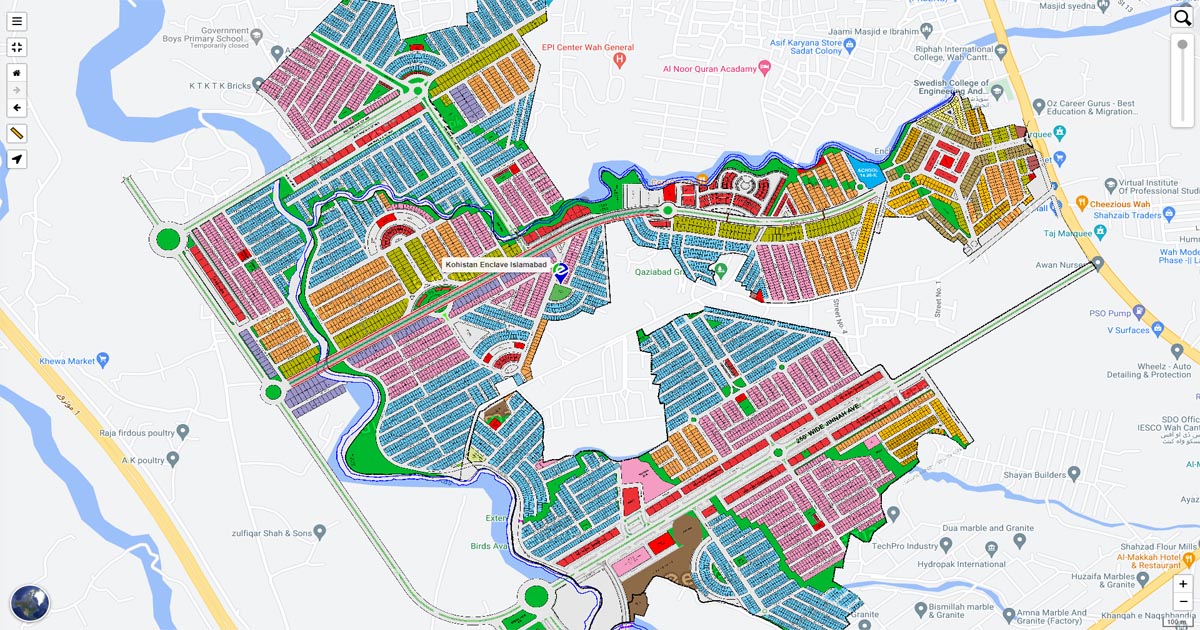Moving into a new housing community is an exciting venture, but understanding your new neighborhood starts with having the right tools at your fingertips. One of the most essential resources is the community layout plan. For residents of specific developments, like the one detailed in the kohistan enclave map, this map guides you to every important amenity, from access roads and nearby landmarks to shopping districts and parks. It’s more than just lines and blocks it helps you picture your future, giving you valuable insight into commute times, public transport options, sector organization, and nearby attractions.
Why a Master Plan Matters
A master plan is the foundation of every modern residential enclave. Crafted by expert urban planners and architects, it lays out the sector and block layout, placement of parks, mosques, schools, healthcare centers, and commercial areas to foster an ideal balance between convenience and comfort. These professionals many with decades of experience in town planning—design master plans that ensure logical zoning, smooth access to utilities, and efficient drainage infrastructure, as recommended by the PCATP and established municipal guidelines. By recognizing green belts, sidewalks, and thoughtfully designed access roads on your map, you’re better equipped to visualize the overall quality of life and anticipate future growth, amenities, and investment opportunities within the community.
How to Read a Sector and Block Layout
Community maps are often divided into distinct sectors and then subdivided into blocks, making orientation simple for newcomers. For example, when exploring the kohistan enclave map, you’ll notice each area labeled in a grid system like “Sector B” or “Block 4.” This system is modeled after globally recognized land use planning practices and helps residents, guests, and service providers easily find directions to specific homes or amenities.
Understanding this organization is key for locating your property, calculating commute times to work or school, and identifying the proximity to key amenity clusters such as parks, mosques, or shopping centers. Routes to main or internal roads, and parking zones, are also clearly marked to aid navigation. This clarity and ease of navigation are core principles of community mapping, upheld by experienced developers and planners for projects of this scale.
Locating Key Amenities and Facilities
The heart of any community is its access to amenities. A well-structured residential map marks locations for a wide array of facilities, so you can spot the nearest:
- Parks & Green Spaces: Lush central parks, jogging tracks, and green belts for recreation and relaxation.
- Educational Institutions: Renowned schools and learning centers easily accessible from every sector.
- Healthcare Services: Hospitals, clinics, and pharmacies located within or near each block.
- Shopping Districts: Markets, superstores, and local shops for daily needs, plus convenience stores scattered throughout.
- Mosques & Community Centers: Places of worship and social gathering hubs strategically positioned for ease of access.
- Sports Facilities: Cricket grounds, tennis courts, and fitness centers, often co-located with parks.
Proximity to these amenity clusters on your map ensures that every family member’s needs are just a short walk or drive away, adding value to daily living.
Understanding Connectivity and Access Roads
Efficient access roads and strong connectivity are vital for a comfortable lifestyle. On your residential map, you’ll see an interconnected web of main boulevards, service lanes, and side streets that link every part of the neighborhood. The map also shows key entry and exit points the routes connecting the enclave to major highways. And city centers which affect commute times to work, schools, or other city attractions.
Presence of public transport stands, ride-sharing points, and well-planned street lighting along main arteries supports safe and easy movement, whether by car, on foot, or via local buses. Directions to neighboring sectors and nearby attractions are often highlighted, ensuring you never miss a landmark or destination.
Decoding Plot Sizes and Zoning
One of the standout features of a detailed community map is its ability to communicate zoning and plot sizes at a glance. Within the kohistan enclave map, you’ll see clear distinctions between residential, commercial, and public zones. Look for plot outlines marked as 5 marla, 10 marla, or 1 kanal, alongside commercial properties and community buildings.
Zoning regulations are vital for understanding permissible land use, guiding homebuyers in their investment decisions. And ensuring peaceful coexistence between residential quiet and business activity. Detailed block layouts and color-coded areas clarify which regions developers reserve for specific purposes and illustrate potential for future development or resale value.
The Role of Security and Utilities
A secure and well-equipped environment is a top priority in planned communities. Community maps typically pinpoint locations of security features like main gates, boundary walls. Surveillance points, and guard posts giving residents peace of mind.
Maps also designate where utilities such as water lines, the electrical grid, gas supply, and sewerage and drainage systems run. Reliable infrastructure underpins daily comfort, while the inclusion of features like solar street lighting and planned waste collection points show commitment to quality living standards. Sidewalks and pedestrian walkways, marked for safety, further enhance community accessibility and connectivity.
Future Development and Investment Potential
An effective community map is both a snapshot of the present and a window into future development updates. Alongside completed sectors, many plans mark out zones reserved for upcoming projects such as new sectors, commercial centers, schools, clinics, or recreational clusters. These “future development” areas are a sign of the enclave’s evolving nature.
For investors and homeowners, understanding timelines for possession, likely appreciation, and resale value is crucial. Properties close to planned developments or infrastructure upgrades often see increased demand. The master plan thus serves as a trusted guide to both lifestyle enhancement and capital growth. Independent market research from sources like Estate Land Marketing suggests that real estate in well-planned societies typically appreciates faster due to organized infrastructure and a transparent future roadmap.
Conclusion
A comprehensive community guide isn’t just for getting around it’s your roadmap for building the life you envision. A resource like the kohistan enclave map doesn’t just show streets and plot numbers. But offers a full understanding of sector layouts, amenity locations, robust road networks, and future development plans. Whether you’re a new resident charting the best routes to school and shopping, or a property seeker assessing resale and investment value. The right map connects you to every opportunity your new neighborhood holds.
Frequently Asked Questions (FAQs)
What is the purpose of a master plan in a housing society?
A master plan is a long-term blueprint organizing land use, amenity clusters, access roads, utilities. And communal green spaces, ensuring residents enjoy convenience, safety, and sustained value over time.
How do I find my plot on a large community map?
Use the map legend to locate your sector and block; the map marks plots with unique numbers and labels streets for easy navigation. Look for nearby landmarks to make orientation easier.
What do different colors on a map usually mean?
Color codes distinguish between residential plot sizes, commercial areas, parks, public facilities, and access routes. Green typically shows parks or green belts, while blue may mark water bodies or utilities.
Why is it important to know about future development areas?
Upcoming development zones indicate where new amenities, schools, or commercial centers are planned. Awareness helps buyers anticipate increases in property value and plan their investments or possession timelines for future needs.
How can a map help with daily commute and transport options?
Mapping highlights access roads, public transport stands. And direct routes to city centers or nearby attractions, making commute planning easy and efficient for residents.




